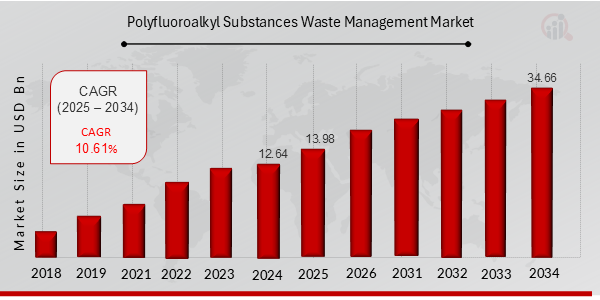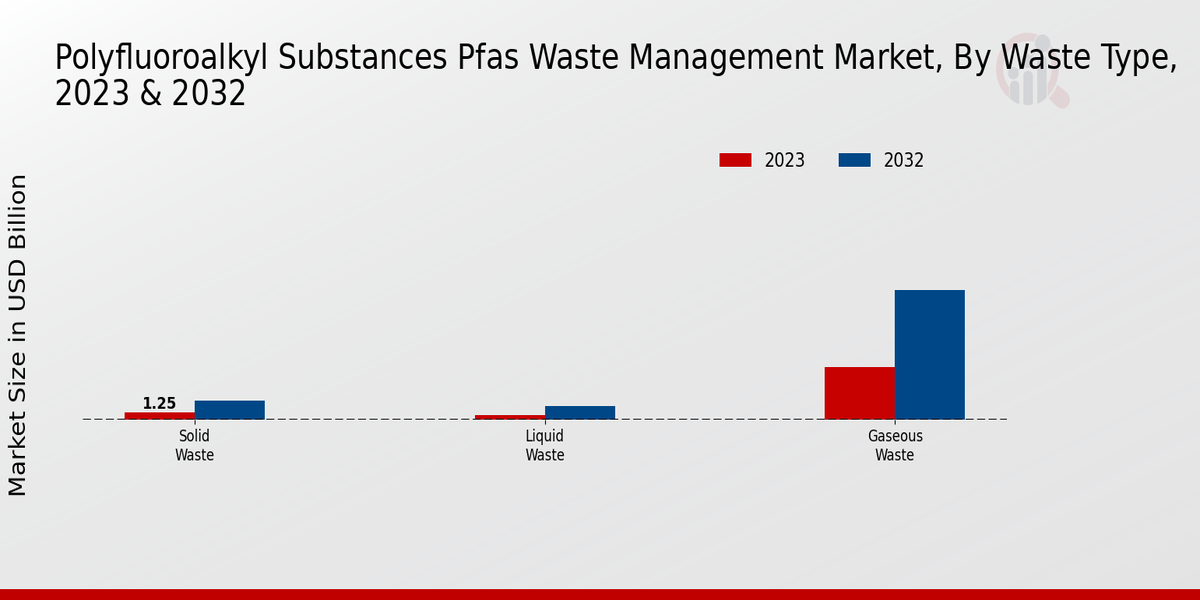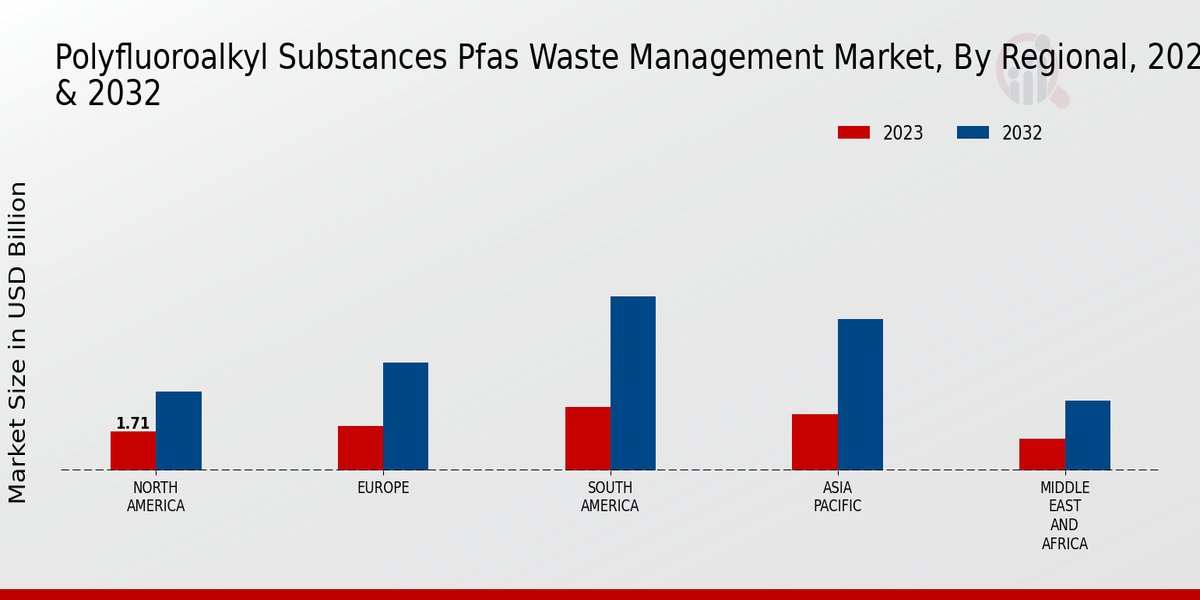Global Polyfluoroalkyl Substances Pfas Waste Management Market Overview
As per MRFR analysis, the Polyfluoroalkyl Substances Waste Management Market Size was estimated at 12.64 (USD Billion) in 2024. The Polyfluoroalkyl Substances Waste Management Market Industry is expected to grow from 13.98 (USD Billion) in 2025 to 34.66 (USD Billion) till 2034, at a CAGR (growth rate) is expected to be around 10.61% during the forecast period (2025 - 2034).
Key Polyfluoroalkyl Substances Pfas Waste Management Market Trends Highlighted
Increasing environmental concerns and stringent regulations regarding the management of PFAS waste are driving the growth of the global PFAS waste management market. Technological advancements in treatment methods, such as incineration, thermal desorption, and electrochemical oxidation, are providing opportunities for market expansion.
The trend towards sustainable waste management practices and the rising adoption of PFAS-free alternatives are shaping market dynamics. Key drivers include growing awareness of the harmful effects of PFAS on human health and the environment, leading to stricter regulations and policies. Moreover, increasing investments in research and development of innovative waste management technologies are expected to further fuel market growth.

Source: Primary Research, Secondary Research, MRFR Database and Analyst Review
Polyfluoroalkyl Substances Pfas Waste Management Market Drivers
Rising Awareness of PFAS Contamination and Health Risks
Polyfluoroalkyl substances (PFAS) are a group of man-made chemicals that have been used in a wide range of industrial and consumer products, including non-stick cookware, waterproof clothing, and fire-fighting foam. In recent years, there has been growing awareness of the health risks associated with PFAS exposure, including cancer, birth defects, and immune system dysfunction. This has led to increased demand for PFAS waste management services as companies and governments seek to reduce their liability and protect public health.
According to a study by the Environmental Working Group, PFAS has been detected in the blood of 99% of Americans. The study also found that exposure to PFAS is linked to an increased risk of cancer, birth defects, and immune system dysfunction. These findings have raised concerns among consumers and regulators and have led to a growing demand for PFAS waste management services.
The Polyfluoroalkyl Substances Pfas Waste Management Market Industry is expected to grow significantly in the coming years, driven by the rising awareness of PFAS contamination and health risks. Companies that provide PFAS waste management services are well-positioned to benefit from this growth.
Increasing Stringency of Environmental Regulations
Governments around the world are increasingly enacting regulations to limit the use and disposal of PFAS. For example, the European Union has banned the use of PFAS in fire-fighting foam, and the United States is considering a similar ban. These regulations are creating a strong demand for PFAS waste management services as companies seek to comply with the law and avoid fines.
In addition to government regulations, many companies are also adopting voluntary PFAS reduction programs. For example, McDonald's has committed to phasing out PFAS from its packaging by 2025. These voluntary programs are also creating demand for PFAS waste management services as companies seek to reduce their environmental footprint.
Development of New PFAS Treatment Technologies
The development of new PFAS treatment technologies is also driving the growth of the Polyfluoroalkyl Substances Pfas Waste Management Market Industry. Traditional PFAS treatment methods, such as incineration and landfilling, are often ineffective or expensive. However, new technologies, such as electrochemical oxidation and plasma treatment, are more effective and cost-effective. These new technologies are making it possible to treat PFAS-contaminated water and soil, which is creating new opportunities for PFAS waste management companies.
Polyfluoroalkyl Substances Pfas Waste Management Market Segment Insights
Polyfluoroalkyl Substances Pfas Waste Management Market Waste Type Insights
The Polyfluoroalkyl Substances Pfas Waste Management Market is segmented based on waste type into solid waste, liquid waste, and gaseous waste. Among these, the solid waste segment held the largest market share in 2023 and is expected to continue its dominance throughout the forecast period. The growth of this segment can be attributed to the increasing generation of solid waste containing PFAS, such as contaminated soil, construction debris, plastic waste management and industrial byproducts. The liquid waste segment is expected to witness a significant growth rate during the forecast period due to the rising volume of wastewater generated from industrial processes and consumer products containing PFAS.
The gaseous waste segment is anticipated to have a moderate growth rate compared to the other segments. The Polyfluoroalkyl Substances Pfas Waste Management Market is driven by the growing awareness about the adverse effects of PFAS on human health and the environment. Governments worldwide are implementing stringent regulations to control the release of PFAS into the environment, which is driving the demand for effective waste management solutions. Technological advancements in PFAS destruction and disposal techniques are also contributing to the growth of the market.
The key players in the Polyfluoroalkyl Substances Pfas Waste Management Market are investing in research and development to develop innovative and cost-effective solutions for PFAS waste management. Partnerships and collaborations among industry stakeholders are also expected to drive the market growth in the coming years. The market is expected to witness significant growth in the Asia-Pacific region due to the increasing industrialization and urbanization in countries like China, India, and Japan.

Source: Primary Research, Secondary Research, MRFR Database and Analyst Review
Polyfluoroalkyl Substances Pfas Waste Management Market Treatment Method Insights
The Polyfluoroalkyl Substances Pfas Waste Management Market is segmented based on Treatment Method into Incineration, Landfilling, Recycling, and Solidification/Stabilization. Incineration held the largest market share in 2023, accounting for over 40% of the global market revenue due to its effectiveness in destroying PFAS compounds. Landfilling is a widely used method due to its low cost and ease of implementation, but it has the potential for PFAS leaching into the environment.
Recycling is gaining traction as a sustainable option, but it is still in its early stages of development.Solidification/stabilization involves treating PFAS waste with binders or solidifying agents to reduce its mobility and toxicity. The market for Solidification/Stabilization is expected to grow significantly in the coming years due to increasing regulatory pressure to find more environmentally friendly disposal methods.
Polyfluoroalkyl Substances Pfas Waste Management Market Waste Generation Source Insights
The Polyfluoroalkyl Substances Pfas Waste Management Market is segmented by waste generation source into industrial manufacturing, consumer products, and wastewater treatment plants. Industrial manufacturing is the largest source of PFAS waste, accounting for over 60% of the global market in 2023. This is due to the use of PFAS in a variety of industrial processes, such as metal plating, semiconductor manufacturing, and textile production. Consumer products are another major source of PFAS waste, accounting for around 25% of the global market in 2023.
PFAS are used in a wide range of consumer products, including non-stick cookware, waterproof clothing, and stain-resistant carpets. Wastewater treatment plants are also a significant source of PFAS waste, accounting for around 15% of the global market in 2023. PFAS can enter wastewater treatment plants from industrial and consumer sources, and they can be difficult to remove from wastewater.
Polyfluoroalkyl Substances Pfas Waste Management Market PFA Content Insights
PFA Content segment of the Polyfluoroalkyl Substances Pfas Waste Management Market is expected to witness significant growth in the coming years. The market is segmented into three categories based on PFA content: Low-Level (500 ppm), Intermediate-Level (500 ppm - 10,000 ppm), and High-Level (>10,000 ppm).
In 2023, the Intermediate-Level segment held the largest share of the market, accounting for around 55% of the Polyfluoroalkyl Substances Pfas Waste Management Market revenue. The growth of this segment is attributed to the increasing demand for waste management services for intermediate-level PFA-contaminated materials.
The High-Level segment is expected to grow at a significant CAGR during the forecast period, owing to the rising environmental concerns and regulations related to the disposal of high-level PFA-contaminated waste.
Polyfluoroalkyl Substances Pfas Waste Management Market Regional Insights
The regional segmentation of the Polyfluoroalkyl Substances Pfas Waste Management Market provides insights into the market size and growth potential across different geographical regions. North America held the largest market share in 2023 and is expected to maintain its dominance during the forecast period. The growth in the region is primarily driven by the increasing awareness about the harmful effects of PFAS on human health and the environment. Europe is another key region, accounting for a significant share of the Polyfluoroalkyl Substances Pfas Waste Management Market.
The region has implemented stringent regulations on the use and disposal of PFAS, which has fueled the demand for waste management solutions. APAC is expected to witness the highest growth rate during the forecast period, owing to the increasing industrialization and urbanization in the region. South America and MEA are also expected to contribute to the growth of the Polyfluoroalkyl Substances Pfas Waste Management Market, albeit at a slower pace.

Source: Primary Research, Secondary Research, MRFR Database and Analyst Review
Polyfluoroalkyl Substances Pfas Waste Management Market Key Players And Competitive Insights:
Major players in Polyfluoroalkyl Substances Pfas Waste Management Market, the competitive scenario is fragmented with numerous players operating in the global market. The Polyfluoroalkyl Substances Pfas Waste Management Market is competitive and highly fragmented globally. The competitive landscape is characterized by the presence of a few major players, such as 3M, Arkema, and Daikin Industries, Ltd. These players have a strong global presence, a wide product portfolio, and a strong distribution network. The other key players in the market include Solvay, Chemours, and AGC. These players are focused on expanding their global reach, developing new products, and strengthening their research and development capabilities. Additionally, several regional and local players are present in the market, catering to specific regional or niche markets.
The Polyfluoroalkyl Substances PFAS Waste Management Market industry is expected to witness significant growth in the coming years, driven by increasing awareness of the adverse effects of PFAS on human health and the environment and the growing demand for effective waste management solutions. One of the leading competitors in the Polyfluoroalkyl Substances Pfas Waste Management Market is 3M. The company has been a pioneer in the development and production of PFAS-based products and has a strong presence in the waste management sector. 3M offers a wide range of PFAS waste management services, including collection, transportation, treatment, and disposal. The company has a global network of facilities and a team of experienced professionals dedicated to providing comprehensive PFAS waste management solutions to its customers. 3M is committed to developing innovative waste management technologies and is actively involved in research and development to improve its offerings.
Another major competitor in the Polyfluoroalkyl Substances Pfas Waste Management Market is Arkema. The company is a global leader in the production of specialty chemicals and has a strong presence in the PFAS market. Arkema offers a range of PFAS waste management services, including thermal destruction, chemical oxidation, and landfill disposal. The company has a global network of facilities and a team of experienced professionals dedicated to providing customized PFAS waste management solutions to its customers. Arkema is focused on developing sustainable waste management practices and is actively involved in research and development to find innovative solutions for the safe and efficient management of PFAS waste.
Key Companies in the Polyfluoroalkyl Substances Pfas Waste Management Market Include
- Chemours
- Asahi Glass
- Kuraray
- Arkema
- BASF
- Shandong Chengxin Chemical
- DIC Corporation
- Wuhan Jinhao Chemical Industry
- 3M
- Daikin Industries
- Zhucheng Hongda Chemical
- Huntsman Corporation
- Solvay
- AGC Chemicals
- Haike Chemical
Polyfluoroalkyl Substances Pfas Waste Management Market Industry Developments
Recent developments and current affairs in the global Polyfluoroalkyl Substances (PFAS) Waste Management Market: Key industry players are focusing on developing innovative technologies to enhance PFAS waste management efficiency and cost-effectiveness.
For instance, in May 2023, Remondis, a leading waste management company, announced a partnership with PFAS Tech, a provider of PFAS destruction technologies, to offer comprehensive PFAS waste management solutions. Regulatory frameworks are evolving to address the growing concerns over PFAS contamination.
In June 2023, the US Environmental Protection Agency (EPA) proposed new regulations for PFAS in wastewater treatment plants, aiming to reduce PFAS discharges into water bodies. Research and development efforts are underway to find sustainable and environmentally friendly PFAS waste management methods.
In April 2023, scientists at the University of California, Berkeley, published a study demonstrating the potential of using photocatalysis to degrade PFAS in water. Market players are exploring partnerships and collaborations to strengthen their offerings.
In March 2023, Veolia, a global environmental services provider, acquired Enviroclean Services, a specialist in PFAS remediation and waste management, to expand its PFAS waste management capabilities. These developments indicate the growing importance of effective PFAS waste management solutions and the ongoing efforts to address the environmental and regulatory challenges associated with PFAS contamination.
Polyfluoroalkyl Substances Pfas Waste Management Market Segmentation Insights
-
Polyfluoroalkyl Substances Pfas Waste Management Market Waste Type Outlook
- Solid Waste
- Liquid Waste
- Gaseous Waste
-
Polyfluoroalkyl Substances Pfas Waste Management Market Treatment Method Outlook
- Incineration
- Landfilling
- Recycling
- Solidification/Stabilization
-
Polyfluoroalkyl Substances Pfas Waste Management Market Waste Generation Source Outlook
- Industrial Manufacturing
- Consumer Products
- Wastewater Treatment Plants
-
Polyfluoroalkyl Substances Pfas Waste Management Market PFA Content Outlook
- Low-Level (500 ppm)
- Intermediate-Level (500 ppm - 10,000 ppm)
- High-Level (>10,000 ppm)
-
Polyfluoroalkyl Substances Pfas Waste Management Market Regional Outlook
- North America
- Europe
- South America
- Asia Pacific
- Middle East and Africa
| Report Attribute/Metric |
Details |
|
Market Size 2024
|
12.64 (USD Billion)
|
|
Market Size 2025
|
13.98 (USD Billion)
|
|
Market Size 2034
|
34.66 (USD Billion)
|
|
Compound Annual Growth Rate (CAGR)
|
10.61% (2025 - 2034)
|
|
Report Coverage
|
Revenue Forecast, Competitive Landscape, Growth Factors, and Trends
|
|
Base Year
|
2024
|
|
Market Forecast Period
|
2025 - 2034
|
|
Historical Data
|
2019 - 2023
|
| Market Forecast Units |
USD Billion |
| Key Companies Profiled |
Chemours, Asahi Glass, Kuraray, Arkema, BASF, Shandong Chengxin Chemical, DIC Corporation, Wuhan Jinhao Chemical Industry, 3M, Daikin Industries, Zhucheng Hongda Chemical, Huntsman Corporation, Solvay, AGC Chemicals, Haike Chemical |
| Segments Covered |
Waste Type, Treatment Method, Waste Generation Source, PFA Content, Regional |
| Key Market Opportunities |
Incineration technologies Advanced oxidation processes Landfill disposal Solidification stabilization techniques Bioremediation |
| Key Market Dynamics |
Increasing Environmental Regulations Growing Demand for Remediation Solutions Technological Advancements in PFAS Destruction Stringent Waste Management Laws Government Initiatives and Funding |
| Countries Covered |
North America, Europe, APAC, South America, MEA |
Frequently Asked Questions (FAQ) :
The global PFAS waste management market is expected to reach USD 34.66 billion by 2034, growing at a CAGR of 10.61% from 2024 to 2032.
North America is expected to hold the largest market share in the global PFAS waste management market due to the presence of stringent environmental regulations and a high concentration of industries that generate PFAS-containing waste.
Key growth drivers of the global PFAS waste management market include increasing awareness of the environmental and health hazards associated with PFAS, stricter environmental regulations, and growing demand for sustainable waste management practices.
Major applications of PFAS waste management services include the treatment and disposal of PFAS-contaminated soil, groundwater, and wastewater, as well as the recycling and reuse of PFAS-containing materials.
Key competitors in the global PFAS waste management market include Veolia, Suez, Waste Management, Clean Harbors, and Stericycle.
Challenges faced by the global PFAS waste management market include the high cost of PFAS treatment and disposal technologies, the lack of standardized regulations for PFAS waste management, and the limited availability of qualified professionals in the field.
Emerging trends in the global PFAS waste management market include the development of innovative PFAS treatment technologies, the increasing adoption of sustainable waste management practices, and the growing demand for PFAS recycling and reuse services.
The COVID-19 pandemic had a moderate impact on the global PFAS waste management market.While some industries that generate PFAS-containing waste experienced a slowdown, the demand for PFAS waste management services remained relatively stable due to the essential nature of these services.
Opportunities for growth in the global PFAS waste management market include the increasing demand for PFAS treatment and disposal services from emerging economies, the development of new and more efficient PFAS treatment technologies, and the growing awareness of the importance of sustainable waste management practices.
Key factors to consider when choosing a PFAS waste management provider include the company's experience and expertise in PFAS waste management, the range of services offered, the cost of services, the company's compliance with environmental regulations, and the company's commitment to sustainability.

















